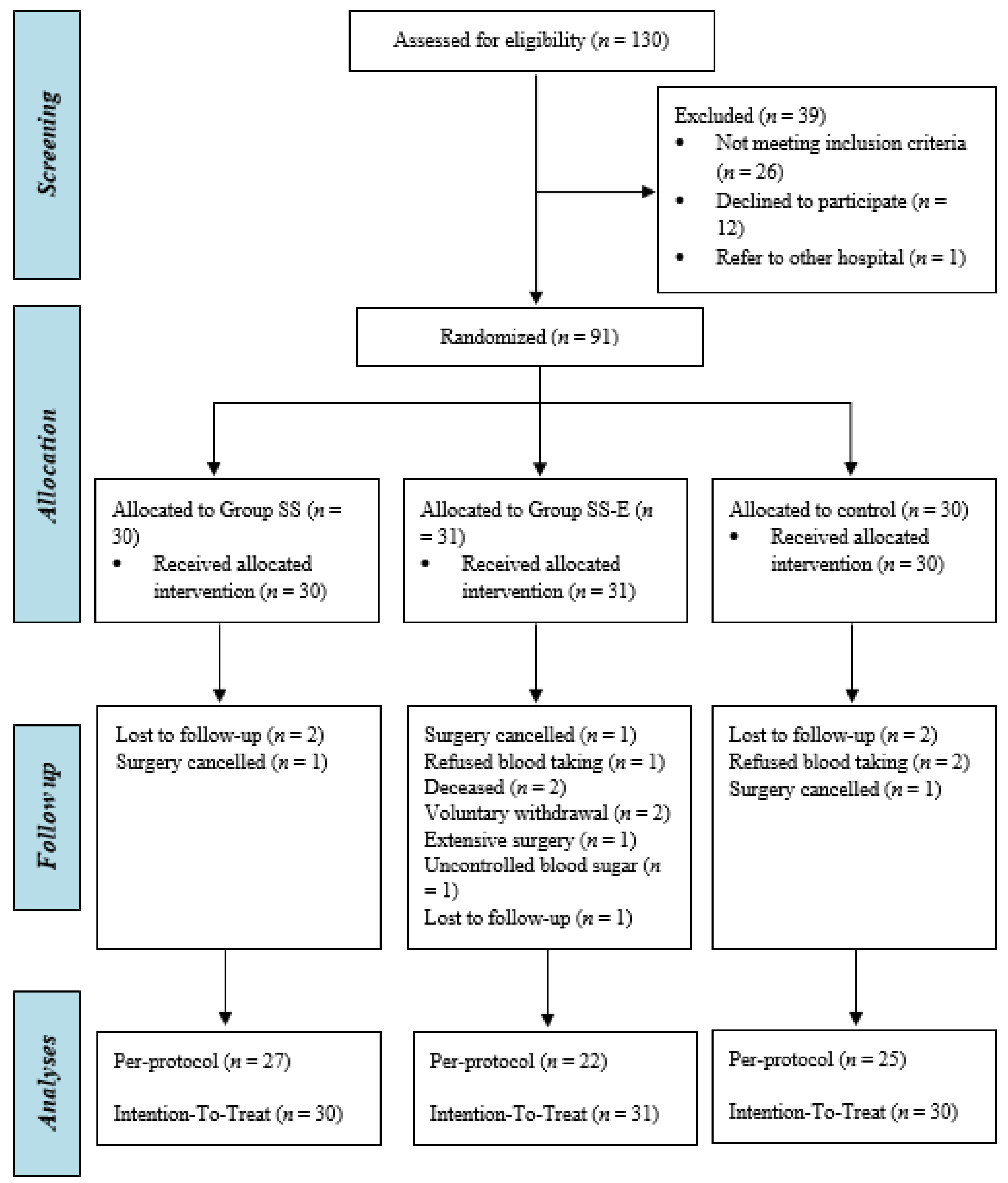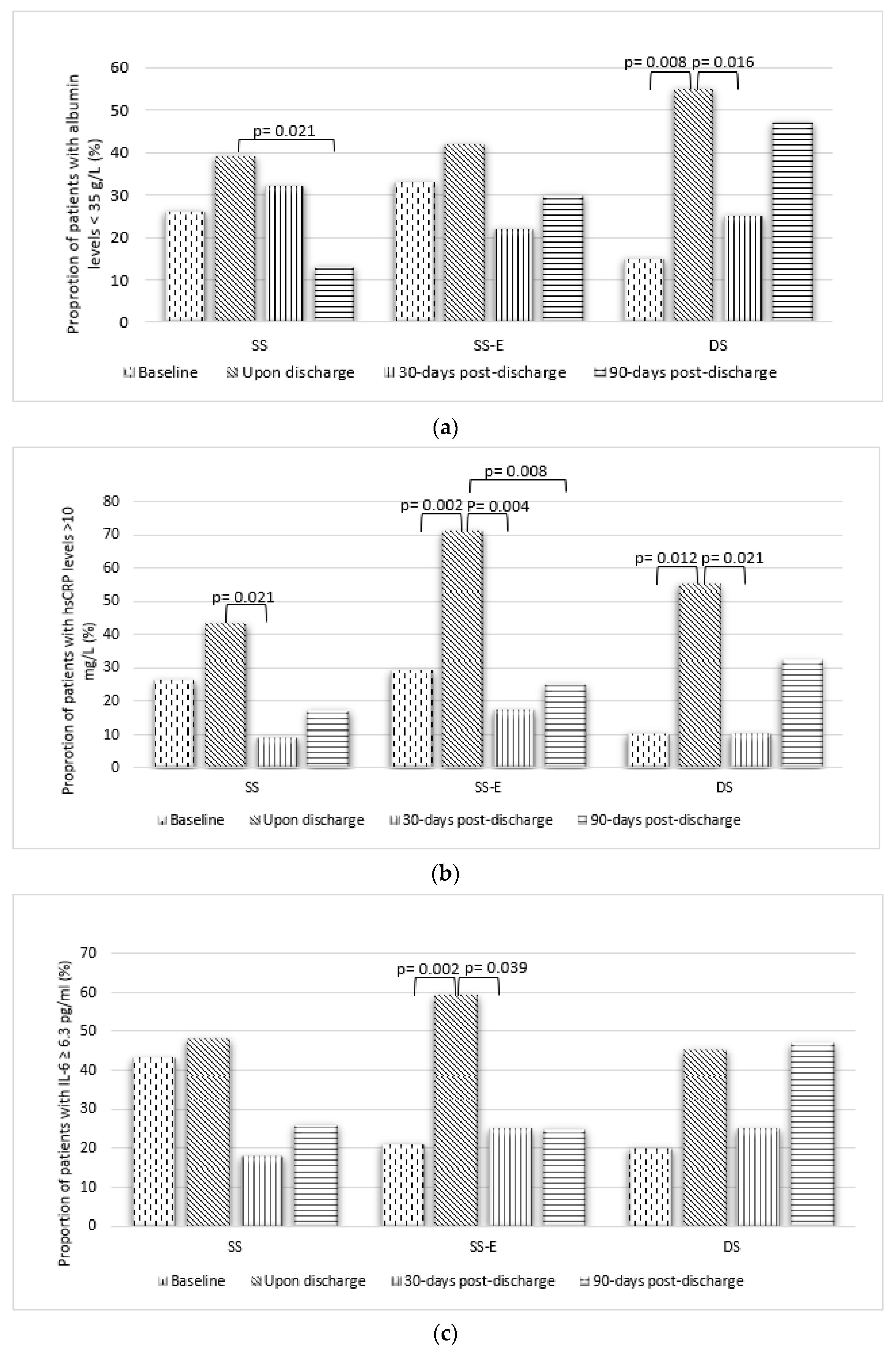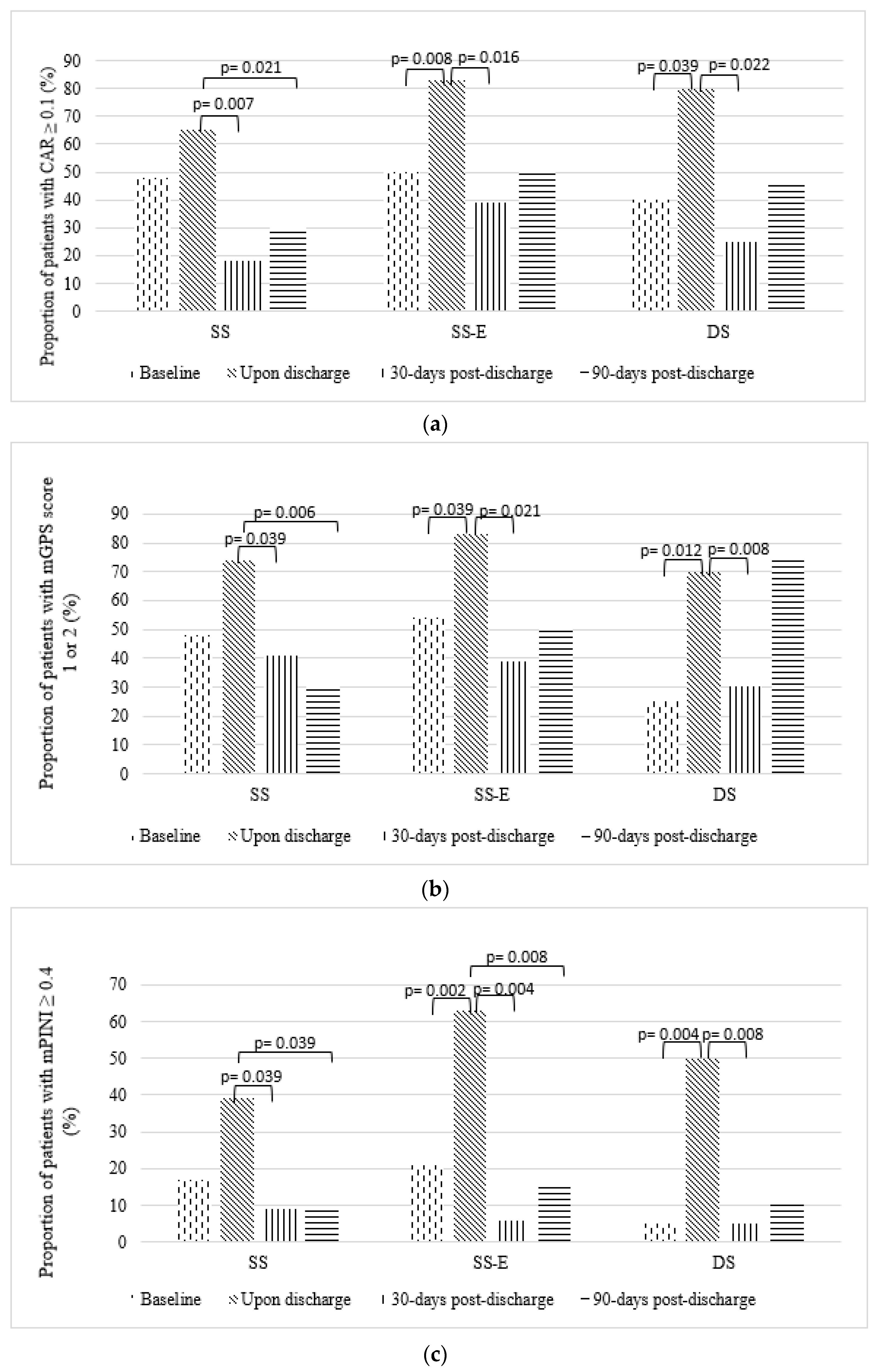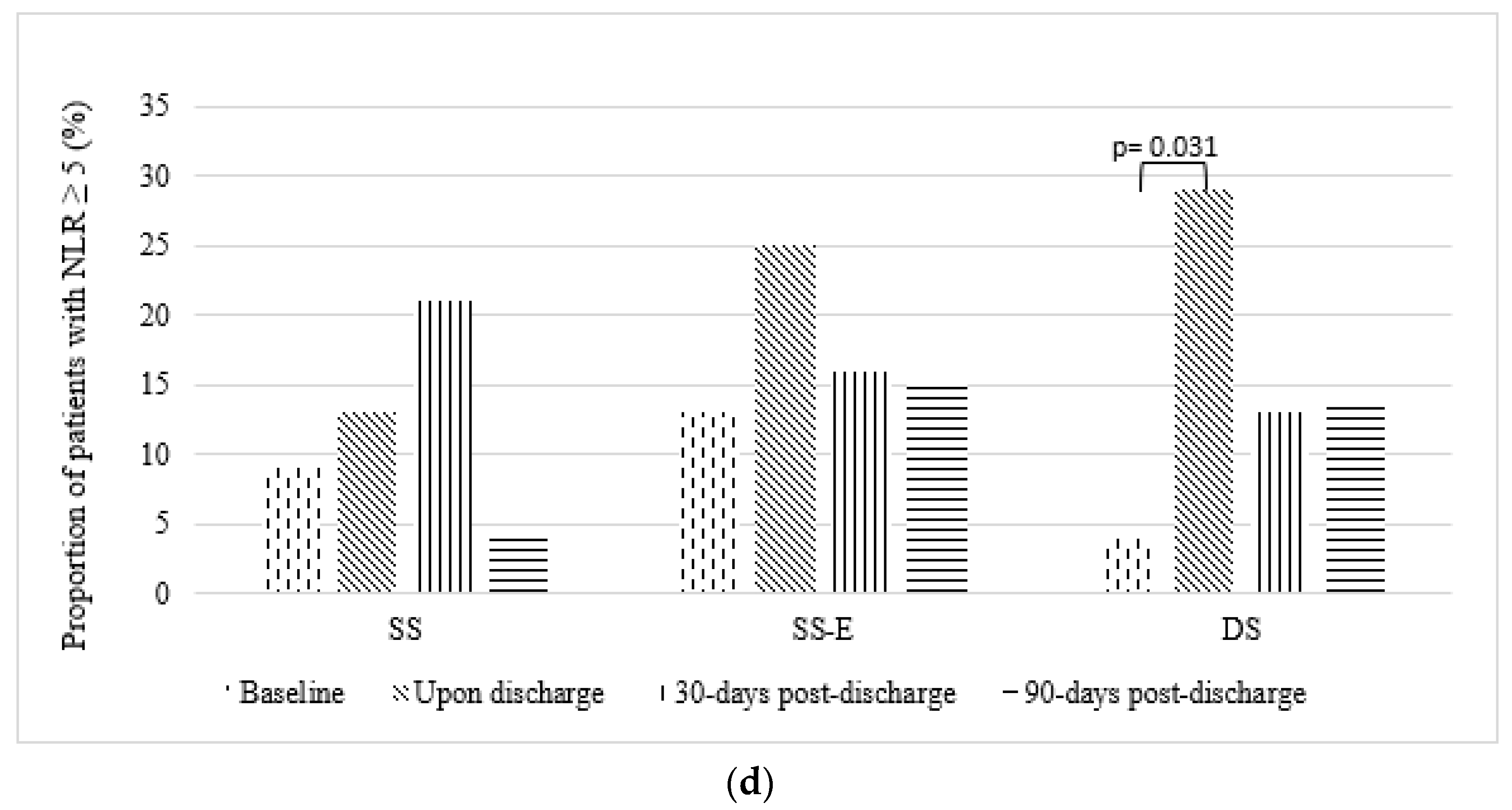Effects of Perioperative Oral Nutrition Supplementation in Malaysian Patients Undergoing Elective Surgery for Breast and Colorectal Cancers—A Randomised Controlled Trial
Abstract
1. Introduction
2. Materials and Methods
2.1. Study Design
2.2. Study Setting and Participants
2.3. Randomisation and Blinding
2.4. Intervention Allocation
2.5. Data Collection and Outcome Measures
2.6. Statistical Analysis
2.7. Sample Size Calculation
3. Results
3.1. Study Participants
3.2. Baseline Characteristics
3.3. Supplementation Duration and Compliance
3.4. Dietary Intake
3.5. Study Outcomes
3.5.1. Primary and Secondary Outcomes
3.5.2. Inflammatory Prognostic Markers
4. Discussion
5. Conclusions
Author Contributions
Funding
Institutional Review Board Statement
Informed Consent Statement
Data Availability Statement
Acknowledgments
Conflicts of Interest
References
- Sung, H.; Ferlay, J.; Siegel, R.L.; Laversanne, M.; Soerjomataram, I.; Jemal, A.; Bray, F. Global Cancer Statistics 2020: GLOBOCAN Estimates of Incidence and Mortality Worldwide for 36 Cancers in 185 Countries. CA Cancer J. Clin. 2021, 71, 209–249. [Google Scholar] [CrossRef] [PubMed]
- Veettil, S.K.; Lim, K.G.; Chaiyakunapruk, N.; Ching, S.M.; Abu Hassan, M.R. Colorectal cancer in Malaysia: Its burden and implications for a multiethnic country. Asian J. Surg. 2017, 40, 481–489. [Google Scholar] [CrossRef] [PubMed]
- DeSantis, C.E.; Lin, C.C.; Mariotto, A.B.; Siegel, R.L.; Stein, K.D.; Kramer, J.L.; Alteri, R.; Robbins, A.S.; Jemal, A. Cancer treatment and survivorship statistics, 2014. CA Cancer J. Clin. 2014, 64, 252–271. [Google Scholar] [CrossRef] [PubMed]
- Norshariza, J.; Siti Farrah Zaidah, M.Y.; Aini Zaharah, A.J.; Betti Sharina, M.H.L.; Neoh, M.K.; Aeininhayatey, A.; Hafizah, N. Prevalence of malnutrition among hospitalised adult cancer patients at the National Cancer Institute, Putrajaya, Malaysia. Malays. J. Nutr. 2017, 23, 161–174. [Google Scholar]
- Kabata, P.; Jastrzębski, T.; Kąkol, M.; Król, K.; Bobowicz, M.; Kosowska, A.; Jaśkiewicz, J. Preoperative nutritional support in cancer patients with no clinical signs of malnutrition—Prospective randomized controlled trial. Support. Care Cancer 2015, 23, 365–370. [Google Scholar] [CrossRef] [PubMed]
- Bruns, E.R.J.; Argillander, T.; Heuvel, B.V.D.; Buskens, C.J.; Van Duijvendijk, P.; Winkels, R.; Kalf, A.; Van Der Zaag, E.S.; Wassenaar, E.B.; Bemelman, W.A.; et al. Oral Nutrition as a Form of Pre-Operative Enhancement in Patients Undergoing Surgery for Colorectal Cancer: A Systematic Review. Surg. Infect. 2018, 19, 1–10. [Google Scholar] [CrossRef] [PubMed]
- Burden, S.T.; Hill, J.; Shaffer, J.L.; Todd, C. Nutritional status of preoperative colorectal cancer patients. J. Hum. Nutr. Diet. 2010, 23, 402–407. [Google Scholar] [CrossRef]
- Bering, T.; Mauricio, S.F.; da Silva, J.B.; Davisson Correia, M.I.T. Nutritional and metabolic status of breast cancer women. Nutr. Hosp. 2015, 31, 751–758. [Google Scholar]
- Ryan, A.M.; Cushen, S.; Ni Bhuachalla, E.; Dwyer, F.; Power, D.G. The Role of Inflammatory Biomarkers in the Assessment of Nutritional Status and Disease States. Top. Clin. Nutr. 2015, 30, 3–15. [Google Scholar] [CrossRef]
- Nicolini, A.; Ferrari, P.; Masoni, M.C.; Fini, M.; Pagani, S.; Giampietro, O.; Carpi, A. Malnutrition, anorexia and cachexia in cancer patients: A mini-review on pathogenesis and treatment. Biomed. Pharmacother. 2013, 67, 807–817. [Google Scholar] [CrossRef]
- Whistance, R.N.; Forsythe, R.O.; McNair, A.G.K.; Brookes, S.T.; Avery, K.; Pullyblank, A.M.; Sylvester, P.A.; Jayne, D.G.; Jones, J.E.; Brown, J.; et al. A systematic review of outcome reporting in colorectal cancer surgery. Color. Dis. 2013, 15, e548–e560. [Google Scholar] [CrossRef] [PubMed]
- Candido, J.; Hagemann, T. Cancer-Related Inflammation. J. Clin. Immunol. 2013, 33, 79–84. [Google Scholar] [CrossRef] [PubMed]
- Fruchtenicht, A.V.G.; Poziomyck, A.K.; DOS Reis, A.M.; Galia, C.R.; Kabke, G.B.; Moreira, L.F. Inflammatory and nutritional statuses of patients submitted to resection of gastrointestinal tumors. Revista do Colégio Brasileiro de Cirurgiões 2018, 45, e1614. [Google Scholar] [CrossRef] [PubMed][Green Version]
- Dolan, R.D.; Lim, J.E.K.; McSorley, S.T.; Horgan, P.G.; McMillan, D.C. The role of the systemic inflammatory response in predicting outcomes in patients with operable cancer: Systematic review and meta-analysis. Sci. Rep. 2017, 7, 16717. [Google Scholar] [CrossRef]
- Zhou, Q.-P.; Li, X.-J. C-Reactive Protein to Albumin Ratio in Colorectal Cancer: A Meta-Analysis of Prognostic Value. Dose-Response 2019, 17, 1559325819889814. [Google Scholar] [CrossRef] [PubMed]
- Helander, E.M.; Webb, M.P.; Menard, B.; Prabhakar, A.; Helmstetter, J.; Cornett, E.M.; Urman, R.D.; Nguyen, V.H.; Kaye, A.D. Metabolic and the Surgical Stress Response Considerations to Improve Postoperative Recovery. Curr. Pain Headache Rep. 2019, 23, 33. [Google Scholar] [CrossRef] [PubMed]
- Zhang, B.; Najarali, Z.; Ruo, L.; Alhusaini, A.; Solis, N.; Valencia, M.; Pinto-Sanchez, M.I.; Serrano, P.E. Effect of Perioperative Nutritional Supplementation on Postoperative Complications—Systematic Review and Meta-Analysis. J. Gastrointest. Surg. 2019, 23, 1682–1693. [Google Scholar] [CrossRef] [PubMed]
- Stratton, R.J.; Elia, M. A review of reviews: A new look at the evidence for oral nutritional supplements in clinical practice. Clin. Nutr. Suppl. 2007, 2, 5–23. [Google Scholar] [CrossRef]
- Mohd, N.S.; Latiff, A.; Ahmad, N.; Islahudin, F. Complications associated with malnutrition in elective surgical patients in a Malaysian setting. Trop. J. Pharm. Res. 2016, 15, 1321–1325. [Google Scholar]
- Wong, T.X.; Chen, S.T.; Ong, S.H.; Shyam, S.; Kandasami, P.; Chee, W.S.S. Study protocol for an open labelled randomised controlled trial of perioperative oral nutrition supplement in breast and colorectal cancer patients undergoing elective surgery. Trials 2021, 22, 767. [Google Scholar] [CrossRef]
- Saklad, M. GRADING OF PATIENTS FOR SURGICAL PROCEDURES. Anesthesiol. 1941, 2, 281–284. [Google Scholar] [CrossRef]
- White, J.V.; Guenter, P.; Jensen, G.; Malone, A.; Schofield, M.; Academy Malnutrition Work Group; ASPEN Malnutrition Task Force; ASPEN Board of Directors. Consensus statement: Academy of Nutrition and Dietetics and American Society for Parenteral and Enteral Nutrition: Characteristics recommended for the identification and documentation of adult malnutrition (undernutrition). JPEN J. Parenter Enter Nutr. 2012, 36, 275–283. [Google Scholar] [CrossRef] [PubMed]
- Sealed Envelope Ltd. Create a Blocked Randomization List. 2019. Available online: https://www.sealedenvelope.com/simple-randomiser/v1/lists (accessed on 1 November 2018).
- Gibbs, J.; Cull, W.; Henderson, W.; Daley, J.; Hur, K.; Khuri, S.F. Preoperative serum albumin level as a predictor of operative mortality and morbidity: Results from the National VA Surgical Risk Study. Arch. Surg. 1999, 134, 36–42. [Google Scholar] [CrossRef] [PubMed]
- De Pergola, G.; Silvestris, F. Obesity as a Major Risk Factor for Cancer. J. Obes. 2013, 2013, 291546. [Google Scholar] [CrossRef] [PubMed]
- Ramos Chaves, M.; Boléo-Tomé, C.; Monteiro-Grillo, I.; Camilo, M.; Ravasco, P. The Diversity of Nutritional Status in Cancer: New Insights. Oncologist 2010, 15, 523–530. [Google Scholar] [CrossRef]
- Nasrah, R.; Kanbalian, M.; Van Der Borch, C.; Swinton, N.; Wing, S.; Jagoe, R. Defining the role of dietary intake in determining weight change in patients with cancer cachexia. Clin. Nutr. 2018, 37, 235–241. [Google Scholar] [CrossRef]
- Kocarnik, J.M.; Hua, X.; Hardikar, S.; Robinson, J.; Lindor, N.M.; Win, A.K.; Hopper, J.L.; Figueiredo, J.C.; Potter, J.D.; Campbell, P.T.; et al. Long-term weight loss after colorectal cancer diagnosis is associated with lower survival: The Colon Cancer Family Registry. Cancer 2017, 123, 4701–4708. [Google Scholar] [CrossRef]
- Lobo, D.N.; Gianotti, L.; Adiamah, A.; Barazzoni, R.; Deutz, N.E.; Dhatariya, K.; Greenhaff, P.L.; Hiesmayr, M.; Jakobsen, D.H.; Klek, S.; et al. Perioperative nutrition: Recommendations from the ESPEN expert group. Clin. Nutr. 2020, 39, 3211–3227. [Google Scholar] [CrossRef]
- Curtis, N.J.; West, M.A.; Salib, E.; Ockrim, J.; Allison, A.S.; Dalton, R.; Francis, N.K. Time from colorectal cancer diagnosis to laparoscopic curative surgery—Is there a safe window for prehabilitation? Int. J. Color. Dis. 2018, 33, 979–983. [Google Scholar] [CrossRef]
- Rana, S.K.; Bray, J.; Menzies-gow, J.; Silk, D.B.A.; Jameson, J.; James, J.J.P. Short term benefits of post-operative supplements in surgical patients oral dietary. Clin. Nutr. 1992, 11, 337–344. [Google Scholar] [CrossRef]
- Keele, A.M.; Bray, M.J.; Emery, P.W.; Duncan, H.D.; Silk, D.B. Two phase randomised controlled clinical trial of postoperative oral dietary supplements in surgical patients. Gut 1997, 40, 393–399. [Google Scholar] [CrossRef] [PubMed]
- Beattie, A.H.; Prach, A.T.; Baxter, J.P.; Pennington, C.R. A randomised controlled trial evaluating the use of enteral nutritional supplements postoperatively in malnourished surgical patients. Gut 2000, 46, 813–818. [Google Scholar] [CrossRef] [PubMed]
- Jensen, M.B.; Hessov, I. Dietary supplementation at home improves the regain of lean body mass after surgery. Nutrition 1997, 13, 422–430. [Google Scholar] [CrossRef]
- Anand, A.; Gajra, A. Hand Grip Dynamometry as Prognostic and Predictive Marker in Older Patients With Cancer. J. Gerontol. Geriatr. Res. 2018, 7, 1–6. [Google Scholar] [CrossRef]
- Sato, T.; Aoyama, T.; Hayashi, T.; Segami, K.; Kawabe, T.; Fujikawa, H.; Yamada, T.; Yamamoto, N.; Oshima, T.; Rino, Y.; et al. Impact of preoperative hand grip strength on morbidity following gastric cancer surgery. Gastric Cancer 2016, 19, 1008–1015. [Google Scholar] [CrossRef]
- Paek, J.; Choi, Y.J. Association between hand grip strength and impaired health-related quality of life in Korean cancer survivors: A cross-sectional study. BMJ Open 2019, 9, e030938. [Google Scholar] [CrossRef]
- Mohammad, A.M.; Zaid, Z.A.; Yi, H.C.; Ibrahim, Z.; Yusop NB, M.; Jamhuri, N.; Abd Rahman, Z. Association between quality of life and handgrip strength among malnourished gynaecological cancer outpatients, National Cancer Institute. Malays. J. Nutr. 2020, 26, 245–256. [Google Scholar] [CrossRef]
- Tan, S.; Meng, Q.; Jiang, Y.; Zhuang, Q.; Xi, Q.; Xu, J.; Zhao, J.; Sui, X.; Wu, G. Impact of oral nutritional supplements in post-discharge patients at nutritional risk following colorectal cancer surgery: A randomised clinical trial. Clin. Nutr. 2021, 40, 47–53. [Google Scholar] [CrossRef]
- Williams, J.P.; E Phillips, B.; Smith, K.; Atherton, P.J.; Rankin, D.; Selby, A.L.; Liptrot, S.; Lund, J.; Larvin, M.; Rennie, M.J. Effect of tumor burden and subsequent surgical resection on skeletal muscle mass and protein turnover in colorectal cancer patients. Am. J. Clin. Nutr. 2012, 96, 1064–1070. [Google Scholar] [CrossRef]
- Anjanappa, M.; Corden, M.; Green, A.; Roberts, D.; Hoskin, P.; McWilliam, A.; Choudhury, A. Sarcopenia in cancer: Risking more than muscle loss. Tech. Innov. Patient Support Radiat. Oncol. 2020, 16, 50–57. [Google Scholar] [CrossRef]
- Simonsen, C.; de Heer, P.; Bjerre, E.D.; Suetta, C.; Hojman, P.; Pedersen, B.K.; Svendsen, L.B.; Christensen, J.F. Sarcopenia and Postoperative Complication Risk in Gastrointestinal Surgical Oncology—A Meta-analysis. Ann. Surg. 2018, 250, 187–196. [Google Scholar]
- Clavien, P.A.; Barkun, J.; de Oliveira, M.L.; Vauthey, J.N.; Dindo, D.; Schulick, R.D.; de Santibañes, E.; Pekolj, J.; Slankamenac, K.; Bassi, C.; et al. The clavien-dindo classification of surgical complications: Five-year experience. Ann. Surg. 2009, 250, 187–196. [Google Scholar] [CrossRef] [PubMed]
- Bone, R.C. Sir Isaac Newton, sepsis, SIRS, and CARS. Crit. Care Med. 1996, 24, 1125–1128. [Google Scholar] [CrossRef] [PubMed]
- Heller, A.R.; Groth, G.; Heller, S.C.; Breitkreutz, R.; Nebe, T.; Quintel, M.; Koch, T. N-Acetylcysteine reduces respiratory burst but augments neutrophil phagocytosis in intensive care unit patients. Crit. Care Med. 2001, 29, 272–276. [Google Scholar] [CrossRef] [PubMed]
- Arends, J.; Baracos, V.; Bertz, H.; Bozzetti, F.; Calder, P.C.; Deutz, N.E.P.; Erickson, N.; Laviano, A.; Lisanti, M.P.; Lobo, D.N.; et al. ESPEN expert group recommendations for action against cancer-related malnutrition. Clin. Nutr. 2017, 36, 1187–1196. [Google Scholar] [CrossRef] [PubMed]
- Roxburgh, C.S.; McMillan, D.C. Role of systemic inflammatory response in predicting survival in patients with primary operable cancer. Futur. Oncol. 2010, 6, 149–163. [Google Scholar] [CrossRef] [PubMed]
- Carvalho, T.C.; Cruz, B.C.S.; Viana, M.S.; Martucci, R.B.; Saraiva, D.C.A.; Reis, P.F. Effect of Nutritional Supplementation Enriched with Eicosapentaenoic Acid on Inflammatory Profile of Patients with Oral Cavity Cancer in Antineoplastic Pretreatment: A Controlled and Randomized Clinical Trial. Nutr. Cancer 2017, 69, 428–435. [Google Scholar] [CrossRef] [PubMed]
- Levitt, D.; Levitt, M. Human serum albumin homeostasis: A new look at the roles of synthesis, catabolism, renal and gastrointestinal excretion, and the clinical value of serum albumin measurements. Int. J. Gen. Med. 2016, 9, 229–255. [Google Scholar] [CrossRef]
- Gupta, D.; Lis, C.G. Pretreatment serum albumin as a predictor of cancer survival: A systematic review of the epidemiological literature. Nutr. J. 2010, 9, 69. [Google Scholar] [CrossRef]
- Truong, A.; Hanna, M.H.; Moghadamyeghaneh, Z.; Stamos, M.J. Implications of preoperative hypoalbuminemia in colorectal surgery. World J. Gastrointest. Surg. 2016, 8, 353–362. [Google Scholar] [CrossRef] [PubMed]
- Li, Y.; Zhong, X.; Cheng, G.; Zhao, C.; Zhang, L.; Hong, Y.; Wan, Q.; He, R.; Wang, Z. Hs-CRP and all-cause, cardiovascular, and cancer mortality risk: A meta-analysis. Atherosclerosis 2017, 259, 75–82. [Google Scholar] [CrossRef] [PubMed]
- Yamamoto, T.; Kawada, K.; Obama, K. Inflammation-Related Biomarkers for the Prediction of Prognosis in Colorectal Cancer Patients. Int. J. Mol. Sci. 2021, 22, 8002. [Google Scholar] [CrossRef] [PubMed]
- Yasui, K.; Shida, D.; Nakamura, Y.; Ahiko, Y.; Tsukamoto, S.; Kanemitsu, Y. Postoperative, but not preoperative, inflammation-based prognostic markers are prognostic factors in stage III colorectal cancer patients. Br. J. Cancer 2021, 124, 933–941. [Google Scholar] [CrossRef] [PubMed]
- Miller, K.R.; Wischmeyer, P.E.; Taylor, B.; McClave, S.A. An Evidence-Based Approach to Perioperative Nutrition Support in the Elective Surgery Patient. J. Parenter. Enter. Nutr. 2013, 37, 39S–50S. [Google Scholar] [CrossRef]
- Huhmann, M.B.; August, D. Perioperative Nutrition Support in Cancer Patients. Nutr. Clin. Pract. 2012, 27, 586–592. [Google Scholar] [CrossRef]
- Chen, Z.; Zhang, P.; Xu, Y.; Yan, J.; Liu, Z.; Lau, W.B.; Lau, B.; Li, Y.; Zhao, X.; Wei, Y.; et al. Surgical stress and cancer progression: The twisted tango. Mol. Cancer 2019, 18, 132. [Google Scholar] [CrossRef]




| Variable | Group SS N = 30 | Group SS-E N = 31 | Group DS N = 30 | p-Value |
|---|---|---|---|---|
| Age (year), median (Q1–Q3) | 60 (50–65) | 60 (45–67) | 61 (46–65) | 0.050 |
| Sex | 0.855 | |||
| Male | 6 (20) | 10 (32) | 6 (23) | - |
| Female | 24 (80) | 21 (68) | 24 (77) | - |
| Cancer types | 0.357 | |||
| Breast cancer | 21 (68) | 15 (48) | 17 (57) | - |
| Colorectal cancer | 9 (32) | 16 (52) | 13 (43) | - |
| Comorbidities | ||||
| Diabetes mellitus | 9 (30) | 6 (19) | 9 (30) | 0.551 |
| Hypertension | 14 (47) | 14 (45) | 13 (43) | 0.967 |
| Cardiovascular diseases | 10 (33) | 6 (19) | 9 (30) | 0.441 |
| Body weight (kg), mean ± SD | 65.6 ± 2.8 | 65.0 ± 2.3 | 62.8 ± 2.2 | 0.714 |
| Body Mass Index (kg/m2), mean ± SD | 26.6 ± 6.8 | 26.1 ± 5.0 | 26.3 ± 7.0 | 0.839 |
| Underweight, <18.5 | 3 (10) | 3 (10) | 2 (7) | - |
| Normal, 18.5–24.9 | 12 (40) | 10 (32) | 14 (47) | - |
| Overweight, ≥25.0 | 5 (17) | 10 (32) | 7 (23) | - |
| Obese, ≥30.0 | 10 (33) | 8 (26) | 7 (23) | - |
| Nutritional status, AND/ASPEN | 0.649 | |||
| Well-nourished | 10 (33) | 9 (29) | 9 (30) | - |
| Mild-to-moderately malnourished | 8 (27) | 14 (45) | 11 (37) | - |
| Severely malnourished | 12 (40) | 8 (26) | 10 (33) | - |
| Handgrip strength (kgF), mean ± SD | 27 ± 8 | 27 ± 8 | 25 ± 6 | 0.787 |
| Albumin (g/L), mean ± SD | 40 ± 1 | 38 ± 2 | 41 ± 1 | 0.323 |
| hsCRP (mg/L), mean ± SD | 7.7 ± 2.6 | 11.1 ± 3.2 | 5.8 ± 2.0 | 0.401 |
| IL-6 (pg/mL), mean ± SD | 7.7 ± 2.7 | 7.1 ± 2.0 | 4.5 ± 0.6 | 0.535 |
| Variable | Group SS N = 26 | Group SS-E N = 21 | Group DS N = 25 | p-Value |
|---|---|---|---|---|
| Supplementation Duration, days, median (Q1–Q3) | ||||
| Preoperative | 8 (6–14) | 7 (4–13) | - | 0.144 |
| 30-days post-discharge | - | 29 (26–35) | - | - |
| 90-days post-discharge | - | 63 (56–68) | - | - |
| 30&90-days post-discharge | - | 97 (85–103) | - | - |
| Compliance to ONS, %, mean ± SD | ||||
| Preoperative | 84 ± 19 | 92 ± 17 | - | 0.154 |
| 30-days post-discharge | - | 77 ± 20 | - | - |
| 90-days post-discharge | - | 75 ± 20 | - | - |
| 30&90-days post-discharge | - | 75 ± 16 | - | - |
| Variables | Group SS N = 26 | Group SS-E N = 21 | Group DS N = 25 | p-Value |
|---|---|---|---|---|
| Energy (kcal/d) | ||||
| Baseline | 1134 ± 394 | 1179 ± 317 | 1148 ± 342 | 0.910 |
| Preoperative | 1923 ± 470 a | 1885 ± 255 a | 1115 ± 353 b | <0.001 |
| 30-days post-discharge | 1254 ± 462 a | 1781 ± 307 b | 1238 ± 314 a | <0.001 |
| 90-days post-discharge | 1287 ± 373 a | 1963 ± 326 b | 1346 ± 318 a | <0.001 |
| Protein (g/d) | ||||
| Baseline | 46 ± 20 | 47 ± 16 | 45 ± 17 | 0.934 |
| Preoperative | 79 ± 21 a | 81 ± 16 a | 45 ± 16 b | <0.001 |
| 30-days post-discharge | 51 ± 21 a | 79 ± 17 b | 50 ± 13 a | <0.001 |
| 90-days post-discharge | 52 ± 20 a | 85 ± 18 b | 52 ± 13 a | <0.001 |
| Carbohydrate (g/d) | ||||
| Baseline | 154 ± 55 | 150 ± 42 | 146 ± 48 | 0.838 |
| Preoperative | 227 ± 54 a | 221 ± 37 a | 147 ± 50 b | <0.001 |
| 30-days post-discharge | 166 ± 67 a | 211 ± 41 b | 154 ± 43 a | 0.001 |
| 90-days post-discharge | 164 ± 51 a | 232 ± 46 b | 177 ± 46 a | <0.001 |
| Fat (g/d) | ||||
| Baseline | 36 ± 16 | 43 ± 17 | 43 ± 14 | 0.233 |
| Preoperative | 74 ± 23 a | 73 ± 12 a | 39 ± 13 b | <0.001 |
| 30-days post-discharge | 41 ± 17 a | 67 ± 15 b | 45 ± 16 a | <0.001 |
| 90-days post-discharge | 46 ± 15 a | 77 ± 16 b | 48 ± 15 a | <0.001 |
| Variables | Group SS | Group SS-E | Group DS | Time * Group |
|---|---|---|---|---|
| N = 30 | N = 31 | N = 30 | p-Value | |
| Weight (kg) | 0.214 | |||
| Baseline | 65.6 ± 15.5 | 65.0 ± 13.2 | 62.8 ± 12.5 | |
| Preoperative | 66.1 ± 15.3 a | 65.2 ± 12.9 a,b | 62.5 ± 12.0 b | |
| 30-days post-discharge | 65.3 ± 15.4 | 64.5 ± 12.8 | 61.3 ± 11.9 | |
| 90-days post-discharge | 65.9 ± 15.3 | 65.5 ± 13.5 | 61.7 ± 12.2 | |
| Body mass index (kg/m2) | 0.172 | |||
| Baseline | 26.6 ± 6.8 | 26.2 ± 5.0 | 26.2 ± 6.9 | |
| Preoperative | 26.8 ± 6.8 a | 26.3 ± 5.0 a,b | 26.1 ± 6.7 b | |
| 30-days post-discharge | 26.5 ± 6.7 | 26.1 ± 4.9 | 25.6 ± 6.7 | |
| 90-days post-discharge | 26.7 ± 6.6 a | 26.5 ± 5.2 a | 25.8 ± 6.6 b | |
| Albumin (g/L) | 0.633 | |||
| Baseline | 39 ± 8 | 38 ± 8 | 41 ± 7 | |
| Preoperative | 38 ± 7 | 38 ± 8 | 38 ± 9 | |
| 30-days post-discharge | 38 ± 8 | 39 ± 5 | 39 ± 9 | |
| 90-days post-discharge | 39 ± 6 | 39 ± 8 | 38 ± 7 | |
| Handgrip strength (kgF) | 0.096 | |||
| Baseline | 27 ± 8 | 27 ± 8 | 25 ± 6 | |
| Preoperative | 26 ± 8 | 25 ± 8 | 25 ± 7 | |
| 30-days post-discharge | 27 ± 8 | 27 ± 6 | 25 ± 7 | |
| 90-days post-discharge | 27 ± 9 a,b | 28 ± 7 a | 25 ± 6 b | |
| hsCRP (mg/L) | 0.525 | |||
| Baseline | 7.5 ± 13.1 | 10.8 ± 17.2 | 5.5 ± 9.8 | |
| Preoperative | 6.5 ± 7.4 | 10.9 ± 16.4 | 5.5 ± 8.6 | |
| 30-days post-discharge | 7.5 ± 21.0 | 8.2 ± 17.4 | 3.7 ± 4.1 | |
| 90-days post-discharge | 4.7 ± 5.9 | 14.1 ± 36.0 | 14.4 ± 38.0 | |
| IL-6 (pg/mL) | 0.223 | |||
| Baseline | 7.4 ± 13.6 | 6.8 ± 10.6 | 4.3 ± 2.8 | |
| Preoperative | 13.6 ± 29.8 | 8.0 ± 12.9 | 5.9 ± 4.5 | |
| 30-days post-discharge | 7.6 ± 15.1 | 5.1 ± 2.5 | 4.7 ± 3.1 | |
| 90-days post-discharge | 4.7 ± 2.6 | 6.1 ± 6.2 | 9.3 ± 18.3 |
Publisher’s Note: MDPI stays neutral with regard to jurisdictional claims in published maps and institutional affiliations. |
© 2022 by the authors. Licensee MDPI, Basel, Switzerland. This article is an open access article distributed under the terms and conditions of the Creative Commons Attribution (CC BY) license (https://creativecommons.org/licenses/by/4.0/).
Share and Cite
Wong, T.X.; Wong, W.X.; Chen, S.T.; Ong, S.H.; Shyam, S.; Ahmed, N.; Hamdan, K.H.; Awang, R.R.; Ibrahim, M.R.; Palayan, K.; et al. Effects of Perioperative Oral Nutrition Supplementation in Malaysian Patients Undergoing Elective Surgery for Breast and Colorectal Cancers—A Randomised Controlled Trial. Nutrients 2022, 14, 615. https://doi.org/10.3390/nu14030615
Wong TX, Wong WX, Chen ST, Ong SH, Shyam S, Ahmed N, Hamdan KH, Awang RR, Ibrahim MR, Palayan K, et al. Effects of Perioperative Oral Nutrition Supplementation in Malaysian Patients Undergoing Elective Surgery for Breast and Colorectal Cancers—A Randomised Controlled Trial. Nutrients. 2022; 14(3):615. https://doi.org/10.3390/nu14030615
Chicago/Turabian StyleWong, Ting Xuan, Wei Xiang Wong, Seong Ting Chen, Shu Hwa Ong, Sangeetha Shyam, Nurzarina Ahmed, Khairul Hazim Hamdan, Raflis Ruzairee Awang, Mohd Razali Ibrahim, Kandasami Palayan, and et al. 2022. "Effects of Perioperative Oral Nutrition Supplementation in Malaysian Patients Undergoing Elective Surgery for Breast and Colorectal Cancers—A Randomised Controlled Trial" Nutrients 14, no. 3: 615. https://doi.org/10.3390/nu14030615
APA StyleWong, T. X., Wong, W. X., Chen, S. T., Ong, S. H., Shyam, S., Ahmed, N., Hamdan, K. H., Awang, R. R., Ibrahim, M. R., Palayan, K., & Chee, W. S. S. (2022). Effects of Perioperative Oral Nutrition Supplementation in Malaysian Patients Undergoing Elective Surgery for Breast and Colorectal Cancers—A Randomised Controlled Trial. Nutrients, 14(3), 615. https://doi.org/10.3390/nu14030615






